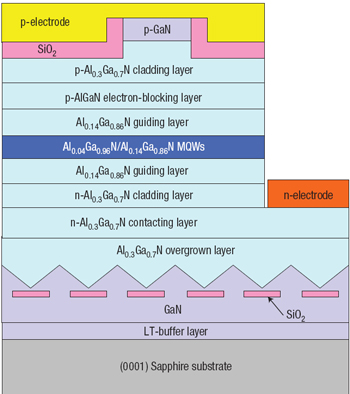
| Home | About Us | Contribute | Bookstore | Advertising | Subscribe for Free NOW! |
| News Archive | Features | Events | Recruitment | Directory |
| FREE subscription |
| Subscribe for free to receive each issue of Semiconductor Today magazine and weekly news brief. |
News
28 July 2008
Hamamatsu shortens wavelength record for UV laser diodes to 342nm
An electrically pumped ultraviolet laser diode (LD) emitting at a 342nm wavelength at room temperature has been produced by Hamamatsu Photonics K.K. in Japan [Yoshida et al, Nature Photonics, advance online publication, 27 July 2008, doi:10.1038/nphoton.2008.135]. The researchers claim that this is the shortest wavelength yet achieved for an electrically driven laser diode.
The device consists of various layers of AlGaN grown on a sapphire substrate. The hetero-facet-controlled epitaxial lateral overgrowth (hetero-FACELO) method is used to reduce dislocation densities and cracking of the base Al0.3Ga0.7N layer. This step is seen as being critical for the achievement of lasing in the completed device. Subsequent layers were grown using metal-organic vapor phase epitaxy (MOVPE).
The active layer consists of an Al0.04Ga0.96N/Al0.14Ga0.86N multi-quantum well (MQW), and is surrounded by Al0.14Ga0.86N guiding layers. The n-type side of the diode consists of doped Al0.3Ga0.7N contacting and cladding layers. The p-type regions consist of doped GaN contacting and Al0.3Ga0.7N cladding layers and an AlGaN electron blocking layer (to prevent electrons overshooting the optically active region).
The researchers stress that their structure is indium-free. Indium has been used in all previous UV laser diode to reduce non-radiating electron-hole recombination in the active layers and hence improve the lasing efficiency. The disadvantage of the use of indium is that it tends to lower the bandgap energy (which is undesirable, since narrower bandgaps lead to longer emission wavelengths).
The device was operated in a pulsed mode (5kHz, pulse width 10ns). Spontaneous emission (i.e. not lasing) was observed at a current of 185mA. The spontaneous emission wavelength was 345nm, with a full-width at half maximum (FWHM) breadth of the spectral line of 6nm. A current of 415mA produces laser emission at 342.7nm and a relatively broad FWHM of 0.9nm. Increasing the current to 512mA shifts the wavelength slightly to 342.3nm and reduces the FWHM to 0.3nm, which is close to the resolution limit of the spectrometer. The separation between the longitudinal modes of the device was 0.25Angstrom (0.025nm), well beyond the resolution of the spectrometer. The laser emission is strongly polarized in a transverse electric (TE) mode.
The threshold current of ~390mA corresponds to a current density of 8.7kA/cm 2. A silicon photodiode measured the output power close to one of the facets as 16mW. The differential external quantum efficiency is estimated at 8.2%. The researchers comment that these characteristics are comparable to those of other, longer-wavelength UV laser diodes, although the resistance of the device is rather high. The higher resistance is related to the increased donor and acceptor ionization frequencies, lowering carrier concentrations, and to degradation of the crystal quality in higher-Al-concentration AlGaN. Reducing the device resistance is seen as the next step to higher-performance continuous-wave operation.

The researchers believe that the low-dislocation-density AlGaN layer production technique opens the way to even shorter-wavelength laser diodes.
Search: UV laser diodes AlGaN Sapphire substrates
Visit: http://dx.doi.org
Visit: http://jp.hamamatsu.com/en
The author Mike Cooke is a freelance technology journalist who has worked in the semiconductor and advanced technology sectors since 1997.